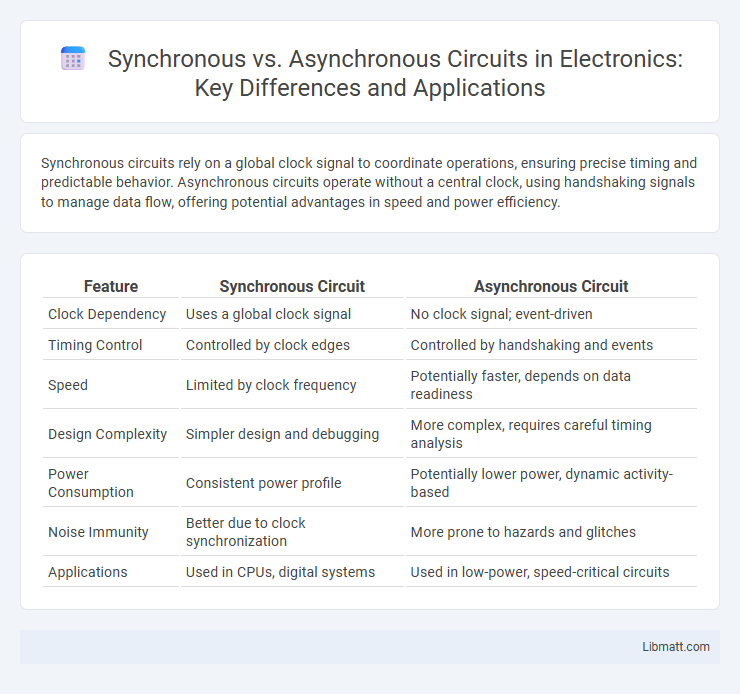Synchronous circuits rely on a global clock signal to coordinate operations, ensuring precise timing and predictable behavior. Asynchronous circuits operate without a central clock, using handshaking signals to manage data flow, offering potential advantages in speed and power efficiency.
Table of Comparison
| Feature | Synchronous Circuit | Asynchronous Circuit |
|---|---|---|
| Clock Dependency | Uses a global clock signal | No clock signal; event-driven |
| Timing Control | Controlled by clock edges | Controlled by handshaking and events |
| Speed | Limited by clock frequency | Potentially faster, depends on data readiness |
| Design Complexity | Simpler design and debugging | More complex, requires careful timing analysis |
| Power Consumption | Consistent power profile | Potentially lower power, dynamic activity-based |
| Noise Immunity | Better due to clock synchronization | More prone to hazards and glitches |
| Applications | Used in CPUs, digital systems | Used in low-power, speed-critical circuits |
Introduction to Synchronous and Asynchronous Circuits
Synchronous circuits operate based on a global clock signal that coordinates data transfer and processing at precise intervals, ensuring predictable timing and easier design verification. Asynchronous circuits function without a global clock, relying on handshaking signals to manage data flow, which can lead to lower power consumption and faster operation in certain applications. Understanding the differences between these two types of circuits helps you optimize performance and efficiency in digital system design.
Defining Synchronous Circuits
Synchronous circuits operate based on a global clock signal that coordinates all changes in state simultaneously, ensuring precise timing and predictable behavior. These circuits rely on clock edges to trigger flip-flops, which store and transfer data in sync with the clock pulse. Understanding synchronous circuits is essential for designing reliable digital systems where timing accuracy and coordination between components are critical.
Understanding Asynchronous Circuits
Asynchronous circuits operate without a global clock, relying on handshaking signals to control data flow and timing between components, which enables faster response times and lower power consumption compared to synchronous designs. These circuits reduce clock skew and eliminate the need for clock distribution networks, making them suitable for applications requiring low electromagnetic interference and high-speed processing. Understanding asynchronous circuit design involves mastering event-driven logic, timing analysis, and methods to avoid hazards such as race conditions and glitches.
Key Differences Between Synchronous and Asynchronous Circuits
Synchronous circuits operate based on a global clock signal, ensuring all components transition states simultaneously, which simplifies timing analysis but can limit speed due to clock distribution delays. Asynchronous circuits function without a global clock, triggering state changes through handshaking signals, allowing for potentially faster operation and lower power consumption but requiring complex design techniques to handle timing uncertainties. The key differences lie in timing control, complexity in design, and performance trade-offs, where synchronous designs favor predictability and ease of debugging, while asynchronous circuits offer speed and power efficiency benefits.
Advantages of Synchronous Circuits
Synchronous circuits offer precise timing control by utilizing a global clock signal, which simplifies design and debugging processes. They provide predictable performance and easier synchronization across different parts of the circuit, enhancing reliability in complex systems. Your digital designs benefit from reduced timing errors and consistent operation across varied environmental conditions.
Advantages of Asynchronous Circuits
Asynchronous circuits offer lower power consumption and reduced electromagnetic interference compared to synchronous designs, making them ideal for energy-efficient applications. Their ability to operate without a global clock allows for faster data processing and better handling of variable latency, enhancing overall system performance. You can achieve improved modularity and easier integration in complex systems due to asynchronous circuits' event-driven nature.
Disadvantages and Challenges of Synchronous Circuits
Synchronous circuits face challenges such as clock skew and jitter, which can cause timing errors and limit overall speed. The reliance on a global clock increases power consumption and complexity, making scaling difficult in large and high-frequency designs. These circuits are also susceptible to performance bottlenecks due to fixed clock cycles, reducing efficiency in variable-latency processing.
Disadvantages and Challenges of Asynchronous Circuits
Asynchronous circuits face challenges such as increased design complexity due to the absence of a global clock, leading to difficulties in ensuring correct timing and synchronization. They are more prone to hazards like race conditions and glitches, which can cause unpredictable behavior and require meticulous verification. Additionally, their debugging and testing processes are more complicated, often resulting in longer development cycles and higher costs compared to synchronous circuits.
Applications: Where Each Circuit Type Excels
Synchronous circuits excel in applications requiring precise timing and coordination, such as microprocessors, digital clocks, and communication systems, where clock-driven operations ensure reliable data processing. Asynchronous circuits shine in low-power, high-speed applications like event-driven systems, embedded controllers, and neuromorphic computing, as they operate without a global clock, reducing latency and power consumption. Choosing the right circuit type depends on your project's need for timing accuracy versus flexibility and efficiency.
Choosing Between Synchronous and Asynchronous Circuits
Choosing between synchronous and asynchronous circuits depends on design requirements such as speed, power consumption, and complexity. Synchronous circuits use a global clock signal to coordinate operations, ensuring predictable timing and easier debugging, making them suitable for high-frequency applications. Asynchronous circuits operate without a clock, reducing power consumption and electromagnetic interference, which benefits low-power and variable-latency designs despite increased design complexity.
Synchronous vs Asynchronous circuit Infographic

 libmatt.com
libmatt.com